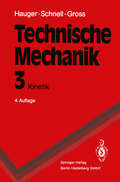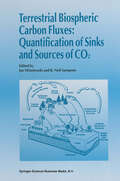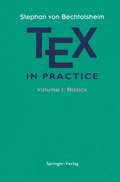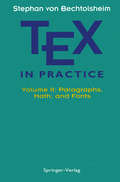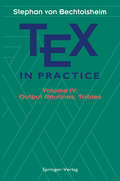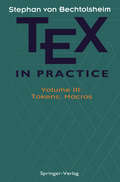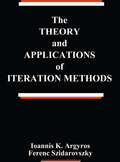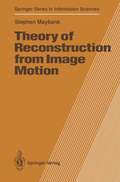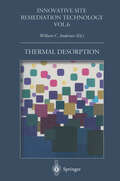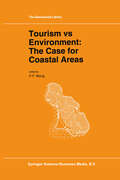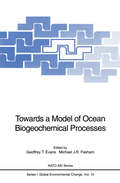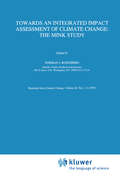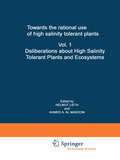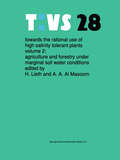- Table View
- List View
Technische Mechanik: Band 3: Kinetik (Springer-Lehrbuch)
by Dietmar Gross Werner Hauger W. Schnell Walter SchnellKinetik ist der dritte Teil des dreibändigen Lehrbuches über Technische Mechanik für Ingenieurstudenten aller Fachrichtungen. Ziel des Werkes ist es, das Verständnis der wesentlichen Grundgesetze der Mechanik zu vermitteln und die Fähigkeiten zu entwickeln, mit Hilfe der Mechanik Ingenieurprobleme zu formulieren und selbständig zu lösen. Es wurde ein möglichst einfacher Zugang zur Mechanik gewählt, um den unterschiedlichen Eingangskenntnissen der Studienanfänger gerecht zu werden und ein tragfähiges Fundament zu legen, das in den Ingenieurfächern und fortführenden Vorlesungen ein tieferes Eindringen in weitergehende Gebiete der Mechanik ermöglicht. Das Werk enthält zahlreiche Beispiele, die der Leser schriftlich nachvollziehen sollte. Band 1 behandelt die Statik, Band 2 die Elastostatik. Auch der dritte Band dieses erfolgreichen Lehrbuches liegt damit in der vierten Auflage vor.
Terrestrial Biospheric Carbon Fluxes Quantification of Sinks and Sources of CO2
by Joe Wisniewski R. Neil SampsonTowards the Balance and Management of the Carbon Budget of the Biosphere The current state of misunderstanding of the global C cycle and our failure to resolve an issue that has been debated for 100 years (Jones and Henderson-Sellers, 1990) speaks loudly about the limitations of modem science when faced with the complexity of the biosphere. Efforts to understand and balance the global C budget have gone through several phases. First was a holistic view of the C budget as part of efforts to understand the geochemistry of the Earth (e. g. , Clarke, 1908). Next, came a period of data collection and sythesis which focused on the diversity of sectors of the biosphere. This phase culminated in the early 1970's with the realization that humans were greatly impacting the global C cycle as measured at the Mauna Loa Observatory (Keeling et al. , 1973). New syntheses of the global C budget emerged at this time (Woodwell and Pacan, 1973; Bolin et al. , 1979). The next phase was one of controversy and intense focus on particular sectors of the biosphere. The controversy rested on discrepancies about the role of the terrestrial biota in the global C cycle and the failure to account for sufficient C sinks to absorb all the C emitted by land-use change in the tropics (Woodwell et al. , 1978, 1983; Houghton et al. , 1983).
TEX in Practice: Volume 1: Basics (Monographs in Visual Communication)
by Stephan v. BechtolsheimTEX has always been regarded as the most elegant and powerful system for computer typesetting. However, its widespread use, beyond academia, was hampered by its complexity. Recently, fairly good TEX implementations have come out for PCs putting TEX on the desks of many people: writers, designers, desktop publishers, engineers, and consequently, the interest in TEX has surged. What is needed at this point is a book that teaches step-by-step how to use TEX, illustrating each step by meaningful examples. This is exactly what S.v. Bechtolsheim's book does. It is a tutorial and guide for the first-time users of TEX, as well as a reference for the most experienced "TEXpert." TEX in Practice will appear as a four volume set, starting with volume 1 Basics, followed by volume 2 Paragraphs, Math and Fonts, volume 3 Tokens, Macros and volume 4 Output Routines, Tables. TEX in Practice will be an indispensable reference for the TEX community and a guide through the first steps for the TEX novice.
TEX in Practice: Volume II: Paragraphs, Math and Fonts (Monographs in Visual Communication)
by Stephan v. BechtolsheimYou might well wonder why TFPC in Practice is a part of the Monographs in Visualization series. However, if you really think about typesetting, especially fine typesetting, you soon realize that in large part it is a visual art as well as a science. 'lEX's algorithms produce in almost all cases aesthetic results of the highest quality. On the other hand, occasionally one may want to insert some additional space before a subscript or superscript, or one may want to adjust the vertical spacing in a fraction. Fortunately Donald Knuth, the author of 'lEX, allows one to program such corrections easily where needed. The four volumes of Stephan von Bechtolsheim's long awaited TFPC in Prac tice present a comprehensive view of 'lEX. His thorough discussion of each aspect of 'lEX is liberally laced with cogent illustrative examples. Many of these exam ples represent complete, ready to use macros that enhance the capabilities of 'lEX. These examples are of particular interest to both the typesetter and the 'lEX programmer. The typesetter can often solve an immediate problem by ei ther using one of the examples directly or by making minor changes to adapt it to the problem at hand. The 'lEX programmer can use the examples, along with Stephan's detailed discussion, to increase both the depth and breadth of his or her knowledge of 'lEX. The value of the text is further enhanced by Stephan's concerted effort to explain the reasoning behind each topic or example.
TEX in Practice: Volume IV: Output Routines, Tables (Monographs in Visual Communication)
by Stephan v. BechtolsheimAlthough you only have one volume in front of you, writing four volumes and 1600 pages on a single subject needs some form of justification. And then on the other hand, why write even more?! Can't, at least, the preface of something that long be short?! Very well, so let's keep it short. It is my sincere hope that the series "'lEX in Practice" will be useful for your own 'lEX work. But please, before you get started, read the "Notes on ''lEX in Practice' ," because it instructs you how to use this series. You will find these notes on pages xxvii-xxxvi. The fourth and last volume deals with two different subject areas. First of all, there are the so-called output routines which are responsible for putting together the pages as generated by 'lEX. You will be amazed at how many different things can be done with 'lEX's output routines. The second subject area we are dealing with in this volume are tables. About a hundred different tables you can choose from should provide you with a starting point in the selection of tables.
TEX in Practice: Volume III: Tokens, Macros (Monographs in Visual Communication)
by Stephan v. BechtolsheimTEX has always been regarded as the most elegant and powerful system for computer typesetting. However, its widespread use beyond academia was hampered by its complexity. Recently, fairly good TEX implementations have come out for PC's putting TEX on the disks of many people including writers, designers, desktop publishers, and engineers. Consequently, interest in TEX has surged. What is needed at this point is a book that teaches step-by-step how to use TEX, illustrating each step with relevant examples. This is exactly what S. v. Bechtolsheim's book does. It is a tutorial and guide for the first-time user of TEX, as well as a reference for the more experienced "TEXpert." TEX in Practice will appear as a four volume set, starting with TEX in Practice, Volume 1: Basics; TEX in Practice, Volume 2: Paragraphs, Math and Fonts; TEX in Practice, Volume 3: Tokens, Macros; TEX in Practice, Volume 4: Output Routines, Tables. TEX in Practice will be an indispensable reference for the TEX community and a guide through the first step for the TEX novice.
The Theory and Applications of Iteration Methods (Systems Engineering Ser.)
by Ioannis K. Argyros Ferenc SzidarovszkyThe Theory and Applications of Iteration Methods focuses on an abstract iteration scheme that consists of the recursive application of a point-to-set mapping. Each chapter presents new theoretical results and important applications in engineering, dynamic economic systems, and input-output systems. At the end of each chapter, case studies and numerical examples are presented from different fields of engineering and economics. Following an outline of general iteration schemes, the authors extend the discrete time-scale Liapunov theory to time-dependent, higher order, nonlinear difference equations. The monotone convergence to the solution is examined in and comparison theorems are proven . Results generalize well-known classical theorems, such as the contraction mapping principle, the lemma of Kantorovich, the famous Gronwall lemma, and the stability theorem of Uzawa. The book explores conditions for the convergence of special single- and two-step methods such as Newton's method, modified Newton's method, and Newton-like methods generated by point-to-point mappings in a Banach space setting. Conditions are examined for monotone convergence of Newton's methods and their variants. Students and professionals in engineering, the physical sciences, mathematics, and economics will benefit from the book's detailed examples, step-by-step explanations, and effective organization.
The Theory and Applications of Iteration Methods
by Ioannis K. Argyros Ferenc SzidarovszkyThe Theory and Applications of Iteration Methods focuses on an abstract iteration scheme that consists of the recursive application of a point-to-set mapping. Each chapter presents new theoretical results and important applications in engineering, dynamic economic systems, and input-output systems. At the end of each chapter, case studies and numerical examples are presented from different fields of engineering and economics. Following an outline of general iteration schemes, the authors extend the discrete time-scale Liapunov theory to time-dependent, higher order, nonlinear difference equations. The monotone convergence to the solution is examined in and comparison theorems are proven . Results generalize well-known classical theorems, such as the contraction mapping principle, the lemma of Kantorovich, the famous Gronwall lemma, and the stability theorem of Uzawa. The book explores conditions for the convergence of special single- and two-step methods such as Newton's method, modified Newton's method, and Newton-like methods generated by point-to-point mappings in a Banach space setting. Conditions are examined for monotone convergence of Newton's methods and their variants. Students and professionals in engineering, the physical sciences, mathematics, and economics will benefit from the book's detailed examples, step-by-step explanations, and effective organization.
Theory of Reconstruction from Image Motion (Springer Series in Information Sciences #28)
by Stephen MaybankThe image taken by a moving camera changes with time. These image motions contain information about the motion of the camera and about the shapes of the objects in the field of view. There are two main types of image motion, finite displacements and image velocities. Finite displacements are described by the point correspondences between two images of the same scene taken from different positions. Image velocities are the velocities of the points in the image as they move over the projection surface. Reconstruction is the task of obtaining from the image-motions information about the camera motion or about the shapes of objects in the field of view. In this book the theory underlying reconstruction is described. Reconstruction from image motion is the subject matter of two different sci entific disciplines, photogrammetry and computer vision. In photogrammetry the accuracy of reconstruction is emphasised; in computer vision the emphasis is on methods for obtaining information from images in real time in order to guide a mechanical device such as a robot arm or an automatic vehicle. This book arises from recent work carried out in computer vision. Computer vision is a young field but it is developing rapidly. The earliest papers on reconstruction in the computer vision literature date back only to the mid 1970s. As computer vision develops, the mathematical techniques applied to the analysis of recon struction become more appropriate and more powerful.
The Theory of Sprays and Finsler Spaces with Applications in Physics and Biology (Fundamental Theories of Physics #58)
by P.L. Antonelli Roman S. Ingarden M. MatsumotoThe present book has been written by two mathematicians and one physicist: a pure mathematician specializing in Finsler geometry (Makoto Matsumoto), one working in mathematical biology (Peter Antonelli), and a mathematical physicist specializing in information thermodynamics (Roman Ingarden). The main purpose of this book is to present the principles and methods of sprays (path spaces) and Finsler spaces together with examples of applications to physical and life sciences. It is our aim to write an introductory book on Finsler geometry and its applications at a fairly advanced level. It is intended especially for graduate students in pure mathemat ics, science and applied mathematics, but should be also of interest to those pure "Finslerists" who would like to see their subject applied. After more than 70 years of relatively slow development Finsler geometry is now a modern subject with a large body of theorems and techniques and has math ematical content comparable to any field of modern differential geometry. The time has come to say this in full voice, against those who have thought Finsler geometry, because of its computational complexity, is only of marginal interest and with prac tically no interesting applications. Contrary to these outdated fossilized opinions, we believe "the world is Finslerian" in a true sense and we will try to show this in our application in thermodynamics, optics, ecology, evolution and developmental biology. On the other hand, while the complexity of the subject has not disappeared, the modern bundle theoretic approach has increased greatly its understandability.
Thermal Desorption (Innovative Site Remediation Technology #6)
by William C. Anderson P.E., DEEThis book is part of a series of eight providing profession-wide, consensus-based assessment of innovative site remediation and hazardous waste treatment technologies.
Thermodynamic Data on Oxides and Silicates: An Assessed Data Set Based on Thermochemistry and High Pressure Phase Equilibrium
by Surendra K. Saxena Nilanjan Chatterjee Yingwei Fei Guoyin ShenTonminerale und Tone: Struktur, Eigenschaften, Anwendungen und Einsatz in Industrie und Umwelt
by Karl Jasmund Gerhard LagalyIm ersten Teil des Buches werden die Tonminerale genau beschrieben und ihre Reaktionen (Ionenaustausch, Quellung, kolloidale Dispersionen, Wechselwirkung mit allen Arten organischer Verbindungen einschließlich von Polymeren) dargestellt. Der Hauptteil enthält das Verhalten der Tonminerale in Böden und die vielfältigen Einsatzmöglichkeiten in Geotechnik und allen möglichen Sparten der Industrie. In diesen Kapiteln finden sich auch Angaben zur Bindung von toxischen Stoffen und Pestiziden und die Verwendung als Abdichtungsmaterialien. Das Buch spricht den Wissenschaftler, Techniker und Ingenieur an, der in der Praxis mit Tonen arbeitet und deren Verwendungsmöglichkeiten prüft sowie den Studenten einschlägiger Fachrichtungen. Die praktische Verwendung der Tone und mögliche Einsatzgebiete sind schwerpunktmäßig behandelt.
Topics in Knot Theory (Nato Science Series C: #399)
by M. E. BozhüyükTopics in Knot Theory is a state of the art volume which presents surveys of the field by the most famous knot theorists in the world. It also includes the most recent research work by graduate and postgraduate students. The new ideas presented cover racks, imitations, welded braids, wild braids, surgery, computer calculations and plottings, presentations of knot groups and representations of knot and link groups in permutation groups, the complex plane and/or groups of motions. For mathematicians, graduate students and scientists interested in knot theory.
Topology of Gauge Fields and Condensed Matter
by M. Monastyrsky''Intended mainly for physicists and mathematicians...its high quality will definitely attract a wider audience.'' ---Computational Mathematics and Mathematical Physics This work acquaints the physicist with the mathematical principles of algebraic topology, group theory, and differential geometry, as applicable to research in field theory and the theory of condensed matter. Emphasis is placed on the topological structure of monopole and instanton solution to the Yang-Mills equations, the description of phases in superfluid 3He, and the topology of singular solutions in 3He and liquid crystals.
Tourism vs Environment: The Case for Coastal Areas (GeoJournal Library #26)
by P. P. WongP.P. Wong ABSTRACT Tourism is environmentally dependent. The unique character ofcoastal areas gives rise to a distinctive tourist development. Although accounts on the impacts ofcoastal tourism can be found in works relating to tourism in general, there are few works specifically on coastal tourism. This present volume focuses on the physical environment of coastal tourism, particularly the geomorphological aspects. The papers deal with basic aspects of the coastal environment for tourism, methodologies for assessing the coastal environment for tourism and empirical studies of various types of coastal environment with tourism development. The resultinggeneralisations are expected to be applied elsewhere. TOURISM AND ENVIRONMENT Environment has various meanings for tourism. In its broadest sense, the environment includes all natural and cultural elements as in OECD's (1981) definition to encompass the natural, built and cultural aspects. This holistic approach is encouraged in understanding the potential impacts arising from tourism. A narrower meaning of environment is the natural and built environment as used by Cohen (1978) and Inskeep (1991: 339). Environment can also be restricted to the natural or physical environment, in order to distinguish it from the economic and social aspects of tourism, as used by tourism researchers (e.g. Mathieson and Wall, 1982; Pearce, 1989). This approach is used predominantly in this volume. Various relationships between tourism and the physical aspects ofthe coast are discussed. There are basic relationships between environment and tourism. Tourism is environmentally dependent and the environment is vulnerable to the impact of tourism.
Towards a Model of Ocean Biogeochemical Processes (NATO ASI Series #10)
by Geoffrey T. Evans and Michael J. R. FashamKey biogeochemical events in the ocean take place in less than a second, are studied in experiments lasting a few hours, and determine cycles that last over seasons or even years. Models of the controlling processes thus have to take into account these time scales. This book aims at achieving consensus among these controlling processes at all relevant time scales. It helps understand the global carbon cycle including the production and breakdown of solved organic matter and the production, sinking and breakdown of particles. The emphasis on considering all time scales in submodel formulation is new and of interest to all those working in global ocean models and related fields.
Towards an Integrated Impact Assessment of Climate Change: The MINK Study
by Norman J. RosenbergGeneral circulation models state that the central United States (and other mid-latitude continental regions) will become warmer and drier as the result of greenhouse warming. On this premise the dustbowl period of the 1930s was selected as an analogue of climate change and its weather records imposed on the Missouri--Iowa--Kansas region to assess how current agriculture, forestry, water resources and energy and the entire regional economy would be affected. The same climate was also imposed on a MINK region forty years into the future, by which time climate change may actually be felt, to assess whether technological and societal change would alter the region's vulnerability to climate change. Another premise of the study was that people would not suffer the impacts of climate change passively, but would use availabe tools to ease the stress. The rising atmospheric concentration of carbon dioxide, expected to be the major cause of greenhouse warming, also works to improve plant growth and reduce plant water use. So the effects of this `Co2 fertilization' were also considered in the analysis. The results, some of them surprising, of this first, fully-integrated analysis of climate change impacts and responses are reported in this book.
Towards the rational use of high salinity tolerant plants: Vol 1: Deliberations about High Salinity Tolerant Plants and Ecosystems (Tasks for Vegetation Science #27)
by Helmut Lieth A. A. Al MasoomThe symposium on high salinity tolerant plants, held at the University of Al Ain in December 1990, dealt primarily with plants tolerating salinity levels exceeding that of ocean water and which at the same time are promising for utilization in agriculture or forestry. The papers of the proceedings of this symposium have been published in two volumes. This volume (1) deals with mangroves and inland high salinity tolerant plants and ecosystems and is divided into the following categories: 1. Vegetation analyses and descriptions of mangroves; 2. Ecosystem analyses; 3. Physiological analyses; 4. Utilization of mangroves and saltmarsh plants; 5. Soil and water analyses. Volume 2 deals with the improvement of salinity tolerance for traditional crops under marginal soils and irrigation water and is published in `Tasks for Vegetation Science' series (TAVS) Vol. 28.
Towards the rational use of high salinity tolerant plants: Vol 2: Agriculture and forestry under marginal soil water conditions (Tasks for Vegetation Science #28)
by Helmut Lieth A. A. Al MasoomThe Symposium on high salinity tolerant plants, held at the University of Al Ain in December 1990, dealt primarily with plants tolerating salinity levels exceeding that of ocean water and which at the same time are promising for utilization in agriculture or forestry. These plants could be very useful for a country like the UAE where fresh water resources are very scarce and the groundwater available at some places is already very salty. More than 60 million woody trees/shrubs have been planted so far and more are planned for the inland plains underlain with brackish groundwater. These species were no solution for the widely barren shoreline of the UAE. Here mangrove species were of potential use, and one species, Avicennia Marina, occurs widely and has been successfully planted for about a decade. Converting the tree plantations into economically useful cropping systems is still a problem requiring much research and development. The book deals in several sections with conventional irrigation systems using marginal water. The species used in these systems are mostly hybrids of conventional crops. The irrigation systems, however, have similar problems as may be expected for irrigation with seawater. Papers show the participants' experiments in this area. The volume serves as a link between scientists working for the improvement of classical irrigation systems and those interested in the application of a new dimension of salinity levels for irrigation water.
Trace Elements in Coal and Coal Combustion Residues
by Robert F. Keefer Kenneth S. SajwanTrace Elements in Coal and Coal Combustion Residues focuses on trace metal chemistry of coal and coal combustion residues. Special emphasis is placed on management of coal combustion residues in electric power plants and the influence of coal and associated residues on soils, plants, water, and animals. Topics covered include a brief summary of research sponsored by Electric Power Research Institute, environmental pollution from coal combustion plants in low-rainfall regions, accumulation of trace elements in freshwater mussels near a power plant, testing to evaluate fossil fuel wastes by chemicals and isotopes, transport of metals from coal piles and ash impoundments, leachability and toxicity of metals in fly ash, and plant absorption of chemicals from ash. The book will be a useful reference for environmental and reclamation consultants, environmental engineers, toxicologists, environmental regulatory personnel, officials with electric power utilities and water treatment plants, and soil scientists.
Trace Elements in Coal and Coal Combustion Residues
by Robert F. Keefer Kenneth S. SajwanTrace Elements in Coal and Coal Combustion Residues focuses on trace metal chemistry of coal and coal combustion residues. Special emphasis is placed on management of coal combustion residues in electric power plants and the influence of coal and associated residues on soils, plants, water, and animals. Topics covered include a brief summary of research sponsored by Electric Power Research Institute, environmental pollution from coal combustion plants in low-rainfall regions, accumulation of trace elements in freshwater mussels near a power plant, testing to evaluate fossil fuel wastes by chemicals and isotopes, transport of metals from coal piles and ash impoundments, leachability and toxicity of metals in fly ash, and plant absorption of chemicals from ash. The book will be a useful reference for environmental and reclamation consultants, environmental engineers, toxicologists, environmental regulatory personnel, officials with electric power utilities and water treatment plants, and soil scientists.
Transport and Diffusion in Turbulent Fields: Modeling and Measurement Techniques
by Hadassah Kaplan Nathan Dinar Avi Lacser Yehudah AlexanderThe 35th OHOLO Conference, which provided the basis for the present book covered a broad range of topics. Basic studies and newly developed methods in modeling atmospheric flows are discussed, besides analyses of concentration fluctuations in different atmospheric conditions, and techniques of data acquisition. The book gives an excellent state-of-the-art impression of the situation in turbulent diffusion and transport.
Trees and Wood in Dendrochronology: Morphological, Anatomical, and Tree-Ring Analytical Characteristics of Trees Frequently Used in Dendrochronology (Springer Series in Wood Science)
by Fritz H. SchweingruberThe science of dendrochronology has grown significantly in the past 20 years. In the 1950s and 1960s, interest in the subject was limited to only a handful of scientists who perceived in dendrochronology a "l'art pour l'art". Today, however, specialists from many different fields recognize and are pursuing the problems of dendrochronology. Tree-ring research has acquired a permanent role in the various sciences of archeology, history, geology, ecology, and climatology. The founders of dendrochronology themselves were of varied scientific backgrounds and interests. For example, A. E. Douglass in the United States was an astronomer, B. Huber in Germany a forest-biologist, and F. N. Shvedov in Russia a climatologist. Today the spectrum is even broader. Many den drochronologists are authorities in mathematics, archeology, history, forestry, botany, wood technology, ecology geography, geology, etc. It is, therefore, understandable that it has become almost impossible for one individual to encompass the entire field. Bitvinskas (1974), Fritts (1976), Schweingruber (1983), and Mitsutani (1990) have attempted, each guided by his own interests, to provide at least an overview of the field. Recently, individual aspects have been presented by groups of authors in books edited by Fletscher (1978), Hughes et al. (1982), Jacoby and Hornbeck (1987) and Bradley and Jones (1992). It is very likely that in the future summaries covering each branch of dendrochronology will be published.
Tropical Africa
by Tony BinnsTropical Africa is a complex and dynamic region. Occupying a marginal position in the world economic system, the region has seemingly insurmountable problems. This book breaks through the complexities with a straightforward and systematic text supported by concise case studies. Covering topics such as population, environment and rural and urban Africa, it builds from an historical base to an understanding of present day patterns and processes and an assessment of future priorities and development strategies. Tropical Africa will prove an invaluable resource for those embarking on any study of this fascinating region.
